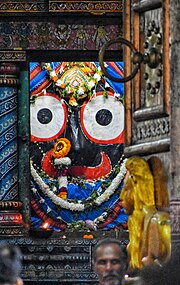

| Odia script | ଚିନ୍ତା କାମୋଦୀ |
|---|---|
| Melā | Sri |
| Jati | Oudaba - Bakra Sampurna |
| Badi | Rusabha |
| Sambadi | Panchama |
| Allied Ragas | Rasa Kamodi |
Chinta Kamodi (Odia: ଚିନ୍ତା କାମୋଦୀ, romanized: chintā kāmodi) is a rāga belonging to the tradition of Odissi music.[1][2][3] Falling under the meḷa Sri,[4] the raga uses both suddha nisada and komala nisada swaras and is traditionally associated with the bhakti rasa.[5] Occasionally, the komala gandhara is employed in a bakra prayoga.
An ancient raga, Chinta Kamodi is accepted as one of the primary melas in Odissi music due to its prominence. It has been used by hundreds of poet-composers for well-over the past many centuries.[6] Its bakra or devious aroha-abaroha are given below:
Aroha: S R M P D S
Abaroha: S N D n D P M G R S
| Oṛiśī Sangīta |
| Odissi music |
|---|

Mahāprabhu Jagannātha
|
| Composers |
| Shāstras |
| Compositions |
| Instruments |
|
|
Some of the well-known traditional compositions in this raga include: